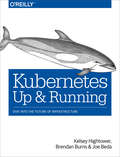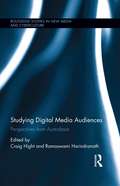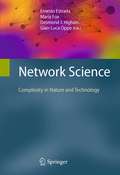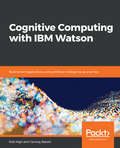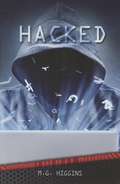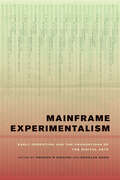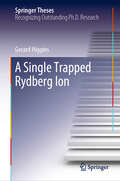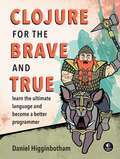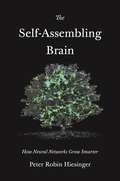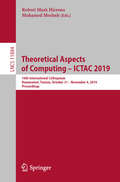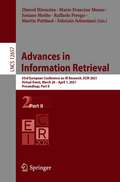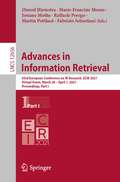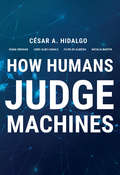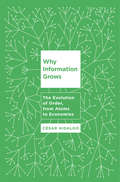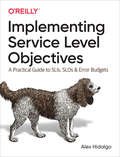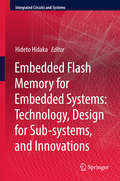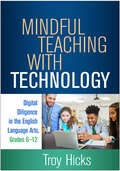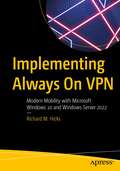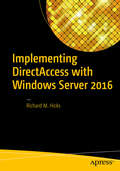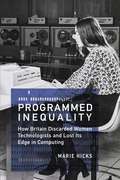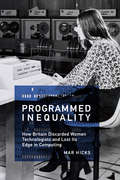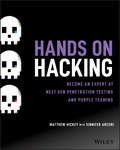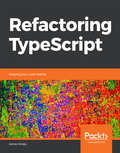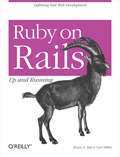- Table View
- List View
Kubernetes: Dive into the Future of Infrastructure
by Kelsey Hightower Brendan Burns Joe BedaLegend has it that Google deploys over two billion application containers a week. How’s that possible? Google revealed the secret through a project called Kubernetes, an open source cluster orchestrator (based on its internal Borg system) that radically simplifies the task of building, deploying, and maintaining scalable distributed systems in the cloud. This practical guide shows you how Kubernetes and container technology can help you achieve new levels of velocity, agility, reliability, and efficiency.Authors Kelsey Hightower, Brendan Burns, and Joe Beda—who’ve worked on Kubernetes at Google and other organizatons—explain how this system fits into the lifecycle of a distributed application. You will learn how to use tools and APIs to automate scalable distributed systems, whether it is for online services, machine-learning applications, or a cluster of Raspberry Pi computers.Explore the distributed system challenges that Kubernetes addressesDive into containerized application development, using containers such as DockerCreate and run containers on Kubernetes, using the docker image format and container runtimeExplore specialized objects essential for running applications in productionReliably roll out new software versions without downtime or errorsGet examples of how to develop and deploy real-world applications in Kubernetes
Studying Digital Media Audiences: Perspectives from Australasia (Routledge Studies in New Media and Cyberculture)
by Craig Hight Ramaswami HarindranathAlthough many digital platforms continue to appropriate and reconfigure familiar forms of media experience, this is an environment which no longer consistently constructs an identifiable 'mass' audience in the terms understood by twentieth century audience researchers. The notion of 'audiencing' takes on different characteristics within a digital environment where platforms encourage users to upload, share and respond to content, while the platforms themselves monetise the digital traces of this activity. This environment demands new ways of thinking about audience and user engagement with media technologies, and raises significant questions on methods of conceiving and researching audience-users. This volume addresses ongoing debates in the field of audience research by exploring relevant conceptual and methodological issues concerning the systematic study of digital audiences. Drawing from work conducted by researchers based in Australia and New Zealand, the book uses theoretical frameworks and case study material which are of direct relevance to audience researchers globally.
Network Science
by Desmond J. Higham Gian-Luca Oppo Ernesto Estrada Maria FoxNetwork Science is the emerging field concerned with the study of large, realistic networks. This interdisciplinary endeavor, focusing on the patterns of interactions that arise between individual components of natural and engineered systems, has been applied to data sets from activities as diverse as high-throughput biological experiments, online trading information, smart-meter utility supplies, and pervasive telecommunications and surveillance technologies. This unique text/reference provides a fascinating insight into the state of the art in network science, highlighting the commonality across very different areas of application and the ways in which each area can be advanced by injecting ideas and techniques from another. The book includes contributions from an international selection of experts, providing viewpoints from a broad range of disciplines. It emphasizes networks that arise in nature--such as food webs, protein interactions, gene expression, and neural connections--and in technology--such as finance, airline transport, urban development and global trade. Topics and Features: begins with a clear overview chapter to introduce this interdisciplinary field; discusses the classic network science of fixed connectivity structures, including empirical studies, mathematical models and computational algorithms; examines time-dependent processes that take place over networks, covering topics such as synchronisation, and message passing algorithms; investigates time-evolving networks, such as the World Wide Web and shifts in topological properties (connectivity, spectrum, percolation); explores applications of complex networks in the physical and engineering sciences, looking ahead to new developments in the field. Researchers and professionals from disciplines as varied as computer science, mathematics, engineering, physics, chemistry, biology, ecology, neuroscience, epidemiology, and the social sciences will all benefit from this topical and broad overview of current activities and grand challenges in the unfolding field of network science.
Cognitive Computing with IBM Watson: Build smart applications using artificial intelligence as a service
by Rob High Tanmay BakshiUnderstand, design, and create cognitive applications using Watson’s suite of APIs.Key FeaturesDevelop your skills and work with IBM Watson APIs to build efficient and powerful cognitive appsLearn how to build smart apps to carry out different sets of activities using real-world use casesGet well versed with the best practices of IBM Watson and implement them in your daily workBook DescriptionCognitive computing is rapidly infusing every aspect of our lives riding on three important fields: data science, machine learning (ML), and artificial intelligence (AI). It allows computing systems to learn and keep on improving as the amount of data in the system grows.This book introduces readers to a whole new paradigm of computing – a paradigm that is totally different from the conventional computing of the Information Age. You will learn the concepts of ML, deep learning (DL), neural networks, and AI through the set of APIs provided by IBM Watson. This book will help you build your own applications to understand, plan, and solve problems, and analyze them as per your needs. You will learn about various domains of cognitive computing, such as NLP, voice processing, computer vision, emotion analytics, and conversational systems, using different IBM Watson APIs.From this, the reader will learn what ML is, and what goes on in the background to make computers "do their magic," as well as where these concepts have been applied. Having achieved this, the readers will then be able to embark on their journey of learning, researching, and applying the concept in their respective fields.What you will learnGet well versed with the APIs provided by IBM Watson on IBM CloudLearn ML, AI, cognitive computing, and neural network principlesImplement smart applications in fields such as healthcare, entertainment, security, and moreUnderstand unstructured content using cognitive metadata with the help of Natural Language UnderstandingUse Watson’s APIs to create real-life applications to realize their capabilitiesDelve into various domains of cognitive computing, such as media analytics, embedded deep learning, computer vision, and moreWho this book is forThis book is for beginners and novices; having some knowledge about artificial intelligence and deep learning is an advantage, but not a prerequisite to benefit from this book. We explain the concept of deep learning and artificial intelligence through the set of tools IBM Watson provides.
Alliance Capitalism, Innovation and the Chinese State: The Global Wireless Sector (International Political Economy Series)
by Victoria HigginsThis book analyses how key 'systems integration' technical pressures, and the increasing use of collaborative alliances for market and product development are impacting on the socio technical policy directives of Chinese State leaders and the strategic behaviour of key Chinese high technology firms operating in the global wireless sector.
Hacked (Red Rhino Nonfiction)
by M. G. Higgins<p>Look out! Your computer data is not safe. There are hackers who will steal it. Sell it. Or destroy it. The hackers are getting smarter. They leave little trace as to their identities. And there are dangerous consequences for individuals, corporations, and governments. <p>Engage your most struggling readers in grades 3-8 with Red Rhino Nonfiction! This new series features high-interest topics in every content area. Visually appealing full-color photographs and illustrations, fun facts, and short chapters keep emerging readers focused. Written at a 1.5-1.9 readability level, these books include pre-reading comprehension questions and a 20-word glossary for comprehension support.</p>
Mainframe Experimentalism: Early Computing and the Foundations of the Digital Arts
by Hannah B. Higgins Douglas KahnMainframe Experimentalism challenges the conventional wisdom that the digital arts arose out of Silicon Valley’s technological revolutions in the 1970s. In fact, in the 1960s, a diverse array of artists, musicians, poets, writers, and filmmakers around the world were engaging with mainframe and mini-computers to create innovative new artworks that contradict the stereotypes of "computer art." Juxtaposing the original works alongside scholarly contributions by well-established and emerging scholars from several disciplines, Mainframe Experimentalism demonstrates that the radical and experimental aesthetics and political and cultural engagements of early digital art stand as precursors for the mobility among technological platforms, artistic forms, and social sites that has become commonplace today.
A Single Trapped Rydberg Ion (Springer Theses)
by Gerard HigginsSystems of trapped ions and systems of ultracold Rydberg atoms are used at the forefront of quantum physics research and they make strong contenders as platforms for quantum technologies. Trapped Rydberg ions are a new hybrid technology envisaged to have both the exquisite control of trapped ion systems and the strong interactions of Rydberg atoms.In this work a single trapped Rydberg ion is experimentally investigated. A trapped strontium ion is excited to Rydberg states using two ultraviolet lasers. Effects of the strong trapping electric fields on the highly-sensitive Rydberg ion are studied. After mitigating unwanted trap effects, the ion is coherently excited to Rydberg states and a quantum gate is demonstrated. This thesis lays much of the experimental groundwork for research using this novel system.
Clojure for the Brave and True: Learn the Ultimate Language and Become a Better Programmer
by Daniel HigginbothamFor weeks, months—nay!—from the very moment you were born, you’ve felt it calling to you. At long last you’ll be united with the programming language you’ve been longing for: Clojure!As a Lisp-style functional programming language, Clojure lets you write robust and elegant code, and because it runs on the Java Virtual Machine, you can take advantage of the vast Java ecosystem. Clojure for the Brave and True offers a "dessert-first" approach: you’ll start playing with real programs immediately, as you steadily acclimate to the abstract but powerful features of Lisp and functional programming. Inside you’ll find an offbeat, practical guide to Clojure, filled with quirky sample programs that catch cheese thieves and track glittery vampires.Learn how to:–Wield Clojure’s core functions–Use Emacs for Clojure development–Write macros to modify Clojure itself–Use Clojure’s tools to simplify concurrency and parallel programmingClojure for the Brave and True assumes no prior experience with Clojure, the Java Virtual Machine, or functional programming. Are you ready, brave reader, to meet your true destiny? Grab your best pair of parentheses—you’re about to embark on an epic journey into the world of Clojure!
The Self-Assembling Brain: How Neural Networks Grow Smarter
by Peter Robin HiesingerWhat neurobiology and artificial intelligence tell us about how the brain builds itself How does a neural network become a brain? While neurobiologists investigate how nature accomplishes this feat, computer scientists interested in artificial intelligence strive to achieve this through technology. The Self-Assembling Brain tells the stories of both fields, exploring the historical and modern approaches taken by the scientists pursuing answers to the quandary: What information is necessary to make an intelligent neural network?As Peter Robin Hiesinger argues, “the information problem” underlies both fields, motivating the questions driving forward the frontiers of research. How does genetic information unfold during the years-long process of human brain development—and is there a quicker path to creating human-level artificial intelligence? Is the biological brain just messy hardware, which scientists can improve upon by running learning algorithms on computers? Can AI bypass the evolutionary programming of “grown” networks? Through a series of fictional discussions between researchers across disciplines, complemented by in-depth seminars, Hiesinger explores these tightly linked questions, highlighting the challenges facing scientists, their different disciplinary perspectives and approaches, as well as the common ground shared by those interested in the development of biological brains and AI systems. In the end, Hiesinger contends that the information content of biological and artificial neural networks must unfold in an algorithmic process requiring time and energy. There is no genome and no blueprint that depicts the final product. The self-assembling brain knows no shortcuts.Written for readers interested in advances in neuroscience and artificial intelligence, The Self-Assembling Brain looks at how neural networks grow smarter.
Theoretical Aspects of Computing – ICTAC 2019: 16th International Colloquium, Hammamet, Tunisia, October 31 – November 4, 2019, Proceedings (Lecture Notes in Computer Science #11884)
by Robert Mark Hierons Mohamed MosbahThis book constitutes the refereed proceedings of the 16th International Colloquium on Theoretical Aspects of Computing, ICTAC 2019, held in Hammamet, Tunisia, in October/November 2019.The 17 revised full papers presented together with 2 keynote papers and 1 industrial paper were carefully reviewed and selected from 138 submissions.The papers are grouped in topical sections on models and transition systems; real-time and temporal logics; verification and concurrency; privacy and security; equations, types, and programming languages.
Advances in Information Retrieval: 43rd European Conference on IR Research, ECIR 2021, Virtual Event, March 28 – April 1, 2021, Proceedings, Part II (Lecture Notes in Computer Science #12657)
by Djoerd Hiemstra Marie-Francine Moens Josiane Mothe Raffaele Perego Martin Potthast Fabrizio SebastianiThis two-volume set LNCS 12656 and 12657 constitutes the refereed proceedings of the 43rd European Conference on IR Research, ECIR 2021, held virtually in March/April 2021, due to the COVID-19 pandemic.The 50 full papers presented together with 11 reproducibility papers, 39 short papers, 15 demonstration papers, 12 CLEF lab descriptions papers, 5 doctoral consortium papers, 5 workshop abstracts, and 8 tutorials abstracts were carefully reviewed and selected from 436 submissions. The accepted contributions cover the state of the art in IR: deep learning-based information retrieval techniques, use of entities and knowledge graphs, recommender systems, retrieval methods, information extraction, question answering, topic and prediction models, multimedia retrieval, and much more.
Advances in Information Retrieval: 43rd European Conference on IR Research, ECIR 2021, Virtual Event, March 28 – April 1, 2021, Proceedings, Part I (Lecture Notes in Computer Science #12656)
by Djoerd Hiemstra Marie-Francine Moens Josiane Mothe Raffaele Perego Martin Potthast Fabrizio SebastianiThis two-volume set LNCS 12656 and 12657 constitutes the refereed proceedings of the 43rd European Conference on IR Research, ECIR 2021, held virtually in March/April 2021, due to the COVID-19 pandemic.The 50 full papers presented together with 11 reproducibility papers, 39 short papers, 15 demonstration papers, 12 CLEF lab descriptions papers, 5 doctoral consortium papers, 5 workshop abstracts, and 8 tutorials abstracts were carefully reviewed and selected from 436 submissions. The accepted contributions cover the state of the art in IR: deep learning-based information retrieval techniques, use of entities and knowledge graphs, recommender systems, retrieval methods, information extraction, question answering, topic and prediction models, multimedia retrieval, and much more.
How Humans Judge Machines
by Cesar A. Hidalgo Diana Orghiain Jordi Albo Canals Filipa De Almeida Natalia MartinHow people judge humans and machines differently, in scenarios involving natural disasters, labor displacement, policing, privacy, algorithmic bias, and more.How would you feel about losing your job to a machine? How about a tsunami alert system that fails? Would you react differently to acts of discrimination depending on whether they were carried out by a machine or by a human? What about public surveillance? How Humans Judge Machines compares people's reactions to actions performed by humans and machines. Using data collected in dozens of experiments, this book reveals the biases that permeate human-machine interactions. Are there conditions in which we judge machines unfairly? Is our judgment of machines affected by the moral dimensions of a scenario? Is our judgment of machine correlated with demographic factors such as education or gender? César Hidalgo and colleagues use hard science to take on these pressing technological questions. Using randomized experiments, they create revealing counterfactuals and build statistical models to explain how people judge artificial intelligence and whether they do it fairly. Through original research, How Humans Judge Machines bring us one step closer tounderstanding the ethical consequences of AI.
Why Information Grows: The Evolution of Order, from Atoms to Economies
by César HidalgoWhat is economic growth? And why, historically, has it occurred in only a few places? Previous efforts to answer these questions have focused on institutions, geography, finances, and psychology. But according to MIT's antidisciplinarian César Hidalgo, understanding the nature of economic growth demands transcending the social sciences and including the natural sciences of information, networks, and complexity. To understand the growth of economies, Hidalgo argues, we first need to understand the growth of order. At first glance, the universe seems hostile to order. Thermodynamics dictates that over time, order--or information--disappears. Whispers vanish in the wind just like the beauty of swirling cigarette smoke collapses into disorderly clouds. But thermodynamics also has loopholes that promote the growth of information in pockets. Although cities are all pockets where information grows, they are not all the same. For every Silicon Valley, Tokyo, and Paris, there are dozens of places with economies that accomplish little more than pulling rocks out of the ground. So, why does the US economy outstrip Brazil's, and Brazil's that of Chad? Why did the technology corridor along Boston's Route 128 languish while Silicon Valley blossomed? In each case, the key is how people, firms, and the networks they form make use of information. Seen from Hidalgo's vantage, economies become distributed computers, made of networks of people, and the problem of economic development becomes the problem of making these computers more powerful. By uncovering the mechanisms that enable the growth of information in nature and society, Why Information Grows lays bear the origins of physical order and economic growth. Situated at the nexus of information theory, physics, sociology, and economics, this book propounds a new theory of how economies can do not just more things, but more interesting things.
Implementing Service Level Objectives: A Practical Guide To Slis, Slos, And Error Budgets
by Alex HidalgoAlthough service-level objectives (SLOs) continue to grow in importance, there’s a distinct lack of information about how to implement them. Practical advice that does exist usually assumes that your team already has the infrastructure, tooling, and culture in place. In this book, recognized SLO expert Alex Hidalgo explains how to build an SLO culture from the ground up.Ideal as a primer and daily reference for anyone creating both the culture and tooling necessary for SLO-based approaches to reliability, this guide provides detailed analysis of advanced SLO and service-level indicator (SLI) techniques. Armed with mathematical models and statistical knowledge to help you get the most out of an SLO-based approach, you’ll learn how to build systems capable of measuring meaningful SLIs with buy-in across all departments of your organization.Define SLIs that meaningfully measure the reliability of a service from a user’s perspectiveChoose appropriate SLO targets, including how to perform statistical and probabilistic analysisUse error budgets to help your team have better discussions and make better data-driven decisionsBuild supportive tooling and resources required for an SLO-based approachUse SLO data to present meaningful reports to leadership and your users
Embedded Flash Memory for Embedded Systems: Technology, Design for Sub-systems, and Innovations
by Hideto HidakaThis book provides a comprehensive introduction to embedded flash memory, describing the history, current status, and future projections for technology, circuits, and systems applications. The authors describe current main-stream embedded flash technologies from floating-gate 1Tr, floating-gate with split-gate (1. 5Tr), and 1Tr/1. 5Tr SONOS flash technologies and their successful creation of various applications. Comparisons of these embedded flash technologies and future projections are also provided. The authors demonstrate a variety of embedded applications for auto-motive, smart-IC cards, and low-power, representing the leading-edge technology developments for eFlash. The discussion also includes insights into future prospects of application-driven non-volatile memory technology in the era of smart advanced automotive system, such as ADAS (Advanced Driver Assistance System) and IoE (Internet of Everything). Trials on technology convergence and future prospects of embedded non-volatile memory in the new memory hierarchy are also described. Introduces the history of embedded flash memory technology for micro-controller products and how embedded flash innovations developed; Includes comprehensive and detailed descriptions of current main-stream embedded flash memory technologies, sub-system designs and applications; Explains why embedded flash memory requirements are different from those of stand-alone flash memory and how to achieve specific goals with technology development and circuit designs; Describes a mature and stable floating-gate 1Tr cell technology imported from stand-alone flash memory products - that then introduces embedded-specific split-gate memory cell technologies based on floating-gate storage structure and charge-trapping SONOS technology and their eFlash sub-system designs; Describes automotive and smart-IC card applications requirements and achievements in advanced eFlash beyond 4 0nm node.
Mindful Teaching with Technology: Digital Diligence in the English Language Arts, Grades 6-12
by Troy HicksTechnology is integral to teaching in the English language arts, whether in-person, hybrid, or remote. In this indispensable guide, Troy Hicks shows how to teach and model "digital diligence"--an alert, intentional stance that helps both teachers and students use technology productively, ethically, and responsibly. Resources and lesson ideas are presented to build adolescents' skills for protecting online privacy, minimizing digital distraction, breaking through &“filter bubbles,&” fostering civil conversations, evaluating information on the Internet, creating meaningful digital writing, and deeply engaging with multimedia texts. Dozens of websites, apps, and other tools are reviewed, with links provided at the companion website; end-of-chapter teaching points and guiding questions facilitate learning and application.
Implementing Always On VPN: Modern Mobility with Microsoft Windows 10 and Windows Server 2022
by Richard M. HicksImplement and support Windows 10 Always On VPN, the successor to Microsoft's popular DirectAccess. This book teaches you everything you need to know to test and adopt the technology at your organization that is widely deployed around the world.The book starts with an introduction to Always On VPN and discusses fundamental concepts and use cases to compare and contrast it with DirectAccess. You will learn the prerequisites required for implementation and deployment scenarios. The book presents the details of recommended VPN protocols, client IP address assignment, and firewall requirements. Also covered is how to configure Routing and Remote Access Service (RRAS) along with security and performance optimizations. The Configuration Service Provider (CSP) is discussed, and you will go through provisioning Always On VPN to Windows 10 clients using PowerShell and XML as well as Microsoft Intune. Details about advanced client configuration and integration with Azure security services are included. You will know how to implement Always On VPN infrastructure in a redundant and highly available (HA) configuration, and guidance for ongoing system maintenance and operational support for the VPN and NPS infrastructure is provided. And you will know how to diagnose and troubleshoot common issues with Always On VPN.After reading this book, you will be able to plan, design, and implement a Windows 10 Always On VPN solution to meet your specific requirements.What Will You LearnPrepare your infrastructure to support Windows 10 Always On VPN on premises or in the cloudProvision and manage Always On VPN clients using modern management methods such as IntuneUnderstand advanced integration concepts for extending functionality with Microsoft AzureTroubleshoot and resolve common configuration and operational errors for your VPNWho This Book Is ForIT professionals and technology administrators for organizations of all sizes
Implementing DirectAccess with Windows Server 2016
by Richard M. HicksLearn how to design, plan, implement, and support a secure remote access solution using DirectAccess in Windows Server 2016. Remote Access has been included in the Windows operating system for many years. With each new operating system release, new features and capabilities have been included to allow network engineers and security administrators to provide remote access in a secure and cost-effective manner. DirectAccess in Windows Server 2016 provides seamless and transparent, always on remote network connectivity for managed Windows devices. DirectAccess is built on commonly deployed Windows platform technologies and is designed to streamline and simplify the remote access experience for end users. In addition, DirectAccess connectivity is bidirectional, allowing administrators to more effectively manage and secure their field-based assets. Implementing DirectAccess with Windows Server 2016 provides a high-level overview of how DirectAccess works. The vision and evolution of DirectAccess are outlined and business cases and market drivers are explained. DirectAccess is evaluated against traditional VPN and this book describes the Windows platform technologies that underpin this solution. In addition, this book: Explains how the technology works and the specific IT pain points that it addressesIncludes detailed, prescriptive guidance for those tasked with implementing DirectAccess using Windows Server 2016Addresses real-world deployment scenarios for small and large organizationsContains valuable tips, tricks, and implementation best practices for security and performance What you ll learn A high-level understanding of the various remote access technologies included in Windows Server 2016. Common uses cases for remote access, and how best to deploy them in a secure, stable, reliable, and highly available manner. Valuable insight in to design best practices and learn how to implement DirectAccess and VPN with Windows Server 2016 according to deployment best practices. Who This Book Is For IT administrators, network, and security administrators and engineers, systems management professionals, compliance auditors, and IT executive management (CIO, CISO) are the target audience for this title. "
Programmed Inequality: How Britain Discarded Women Technologists and Lost Its Edge in Computing
by Marie HicksIn 1944, Britain led the world in electronic computing. By 1974, the British computer industry was all but extinct. What happened in the intervening thirty years holds lessons for all postindustrial superpowers. As Britain struggled to use technology to retain its global power, the nation's inability to manage its technical labor force hobbled its transition into the information age. In Programmed Inequality, Marie Hicks explores the story of labor feminization and gendered technocracy that undercut British efforts to computerize. That failure sprang from the government's systematic neglect of its largest trained technical workforce simply because they were women. Women were a hidden engine of growth in high technology from World War II to the 1960s. As computing experienced a gender flip, becoming male-identified in the 1960s and 1970s, labor problems grew into structural ones and gender discrimination caused the nation's largest computer user -- the civil service and sprawling public sector -- to make decisions that were disastrous for the British computer industry and the nation as a whole.Drawing on recently opened government files, personal interviews, and the archives of major British computer companies, Programmed Inequality takes aim at the fiction of technological meritocracy. Hicks explains why, even today, possessing technical skill is not enough to ensure that women will rise to the top in science and technology fields. Programmed Inequality shows how the disappearance of women from the field had grave macroeconomic consequences for Britain, and why the United States risks repeating those errors in the twenty-first century.
Programmed Inequality: How Britain Discarded Women Technologists and Lost Its Edge in Computing (History of Computing)
by Mar HicksHow Britain lost its early dominance in computing by systematically discriminating against its most qualified workers: women.In 1944, Britain led the world in electronic computing. By 1974, the British computer industry was all but extinct. What happened in the intervening thirty years holds lessons for all postindustrial superpowers. As Britain struggled to use technology to retain its global power, the nation's inability to manage its technical labor force hobbled its transition into the information age. In Programmed Inequality, Mar Hicks explores the story of labor feminization and gendered technocracy that undercut British efforts to computerize. That failure sprang from the government's systematic neglect of its largest trained technical workforce simply because they were women. Women were a hidden engine of growth in high technology from World War II to the 1960s. As computing experienced a gender flip, becoming male-identified in the 1960s and 1970s, labor problems grew into structural ones and gender discrimination caused the nation's largest computer user—the civil service and sprawling public sector—to make decisions that were disastrous for the British computer industry and the nation as a whole.Drawing on recently opened government files, personal interviews, and the archives of major British computer companies, Programmed Inequality takes aim at the fiction of technological meritocracy. Hicks explains why, even today, possessing technical skill is not enough to ensure that women will rise to the top in science and technology fields. Programmed Inequality shows how the disappearance of women from the field had grave macroeconomic consequences for Britain, and why the United States risks repeating those errors in the twenty-first century.
Hands on Hacking: Become an Expert at Next Gen Penetration Testing and Purple Teaming
by Matthew Hickey Jennifer ArcuriA fast, hands-on introduction to offensive hacking techniques Hands-On Hacking teaches readers to see through the eyes of their adversary and apply hacking techniques to better understand real-world risks to computer networks and data. Readers will benefit from the author's years of experience in the field hacking into computer networks and ultimately training others in the art of cyber-attacks. This book holds no punches and explains the tools, tactics and procedures used by ethical hackers and criminal crackers alike. We will take you on a journey through a hacker’s perspective when focused on the computer infrastructure of a target company, exploring how to access the servers and data. Once the information gathering stage is complete, you’ll look for flaws and their known exploits—including tools developed by real-world government financed state-actors. • An introduction to the same hacking techniques that malicious hackers will use against an organization • Written by infosec experts with proven history of publishing vulnerabilities and highlighting security flaws • Based on the tried and tested material used to train hackers all over the world in the art of breaching networks • Covers the fundamental basics of how computer networks are inherently vulnerable to attack, teaching the student how to apply hacking skills to uncover vulnerabilities We cover topics of breaching a company from the external network perimeter, hacking internal enterprise systems and web application vulnerabilities. Delving into the basics of exploitation with real-world practical examples, you won’t find any hypothetical academic only attacks here. From start to finish this book will take the student through the steps necessary to breach an organization to improve its security. Written by world-renowned cybersecurity experts and educators, Hands-On Hacking teaches entry-level professionals seeking to learn ethical hacking techniques. If you are looking to understand penetration testing and ethical hacking, this book takes you from basic methods to advanced techniques in a structured learning format.
Refactoring TypeScript: Keeping your code healthy
by James HickeyDiscover various techniques to develop maintainable code and keep it in shape. Key Features Learn all about refactoring - why it is important and how to do it Discover easy ways to refactor code with examples Explore techniques that can be applied to most other programming languages Book Description Refactoring improves your code without changing its behavior. With refactoring, the best approach is to apply small targeted changes to a codebase. Instead of doing a huge sweeping change to your code, refactoring is better as a long-term and continuous enterprise. Refactoring TypeScript explains how to spot bugs and remove them from your code. You'll start by seeing how wordy conditionals, methods, and null checks make code unhealthy and unstable. Whether it is identifying messy nested conditionals or removing unnecessary methods, this book will show various techniques to avoid these pitfalls and write code that is easier to understand, maintain, and test. By the end of the book, you'll have learned some of the main causes of unhealthy code, tips to identify them and techniques to address them. What you will learn Spot and fix common code smells to create code that is easier to read and understand Discover ways to identify long methods and refactor them Create objects that keep your code flexible, maintainable, and testable Apply the Single Responsibility Principle to develop less-coupled code Discover how to combine different refactoring techniques Learn ways to solve the issues caused by overusing primitives Who this book is for This book is designed for programmers who are looking to explore various refactoring techniques to develop healthy and maintainable code. Some experience in JavaScript and TypeScript can help you easily grasp the concepts explained in this book.
Ruby on Rails: Up and Running
by Curt Hibbs Bruce A. TateRuby on Rails is the super-productive new way to develop full-featured web applications. With Ruby on Rails, powerful web applications that once took weeks or months to develop can now be produced in a matter of days. If it sounds too good to be true, it isn't. If you're like a lot of web developers, you've probably considered kicking the tires on Rails - the framework of choice for the new generation of Web 2.0 developers. Ruby on Rails: Up and Running takes you out for a test drive and shows you just how fast Ruby on Rails can go. This compact guide teaches you the basics of installing and using both the Ruby scripting language and the Rails framework for the quick development of web applications. Ruby on Rails: Up and Running covers just about everything you need - from making a simple database-backed application to adding elaborate Ajaxian features and all the juicy bits in between. While Rails is praised for its simplicity and speed of development, there are still a few steps to master on the way. More advanced material helps you map data to an imperfect table, traverse complex relationships, and build custom finders. A section on working with Ajax and REST shows you how to exploit the Rails service frameworks to send emails, implement web services, and create dynamic user-centric web pages. The book also explains the essentials of logging to find performance problems and delves into other performance-optimizing techniques. As new web development frameworks go, Ruby on Rails is the talk of the town. And Ruby on Rails: Up and Running can make sure you're in on the discussion.
